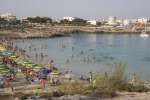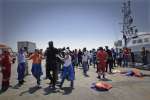Some 8,400 migrants, asylum-seekers reach Italy and Malta by sea in first half of 2013
News Stories, 5 July 2013
ROME, Italy, July 5 (UNHCR) – The UN refugee agency said on Friday that an estimated 8,400 migrants and asylum-seekers landed on the coasts of Italy and Malta in the first six months of this year. The majority arrived in Italy (7,800), while Malta received around 600 migrants and asylum-seekers.
"Those making this journey mostly departed from North Africa, principally Libya – around 6,700 people. The remaining 1,700 crossed from Greece and Turkey, landing in southern Italy's Apulia and Calabria regions," a UNHCR spokesman said.
The high seas crossing is very dangerous and every year people die in the attempt. Pope Francis will visit the Italian island of Lampedusa on Monday to pay tribute to these people and will throw a wreath into the sea.
Countries in sub-Saharan Africa are the main places of origin of these migrants and asylum-seekers, particularly Somalia and Eritrea. Other countries of origin include Egypt, Pakistan and Syria. Nationals of Gambia, Mali and Afghanistan also make these crossings, but in smaller numbers.
The Mediterranean has some of the busiest sea crossings in the world and is also a dangerous frontier for migrants and asylum-seekers en route to southern Europe.
"In view of the perils, UNHCR again calls on all vessels at sea to be on alert for migrants and refugees in need of rescue," spokesman Adrian Edwards said. "We also renew our call to all shipmasters in the Mediterranean to remain vigilant and to carry out their duty of rescuing vessels in distress," he added.
International and European law also requires states to ensure that people intercepted or rescued at sea who seek asylum, can gain access to territory and to an asylum procedure where their international protection needs or claims can be examined.
The peak crossing period for migrants and asylum-seekers runs from May to September. At this time of year, when there is an increase in the number of people trying to make the perilous high seas journey, it is essential to ensure that the long-established tradition of rescue at sea is upheld by all and that international maritime law is adhered to.
For 2012 as a whole, some 15,000 migrants and asylum-seekers reached Italy and Malta (13,200 and 1,800 respectively) by sea. The number arriving in the first six months of 2012 was 4,500 (3,500 in Italy and 1,000 in Malta).
Some 40 people have died trying to make the crossing from Tunisia to Italy during the first six months of 2013, by UNHCR count. In 2012, almost 500 people were reported dead or missing at sea. The decrease in deaths so far in 2013 is thanks in part to the efforts of the Italian and Maltese authorities in effectively coordinating rescue at sea.
UNHCR also welcomes the efforts by the authorities in Italy, Malta and Libya to rescue boats in distress in the Mediterranean, and calls on all states to continue to fulfill their obligations under international refugee law and maritime law.











































